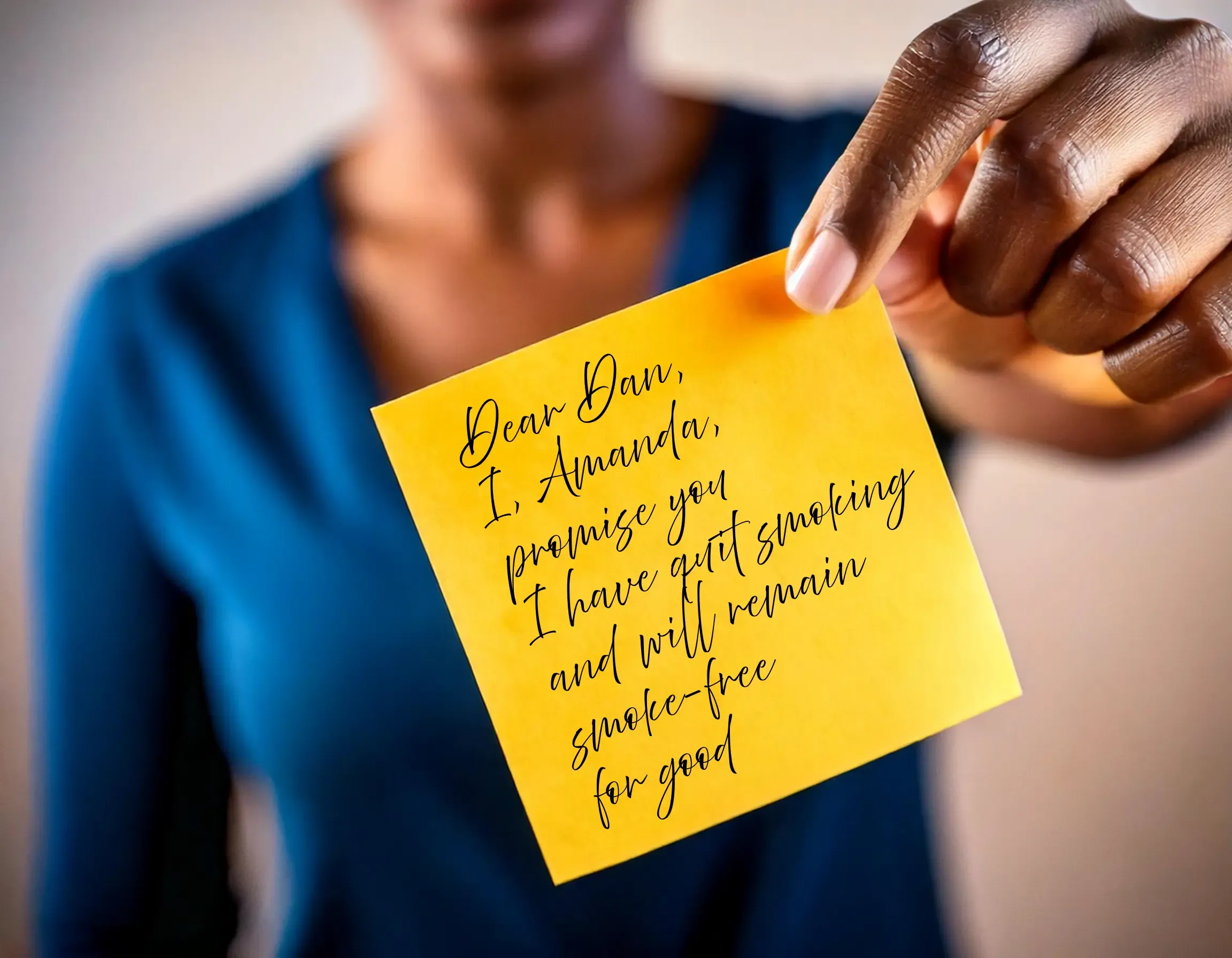The Secret Quit Smoking Support Group You Didn’t Know You Had
Find out how to tap into your hidden support group and boost your chances of quitting smoking by fivefold!
Daniel Stefan
Dec 12, 2024
6 min read

Back in 2013, before the creation of BravoBee, I was just another person trapped in the endless cycle of trying—and failing—to quit smoking. For years, I wrestled with addiction, frustrated by the futility of my efforts. But then, during one ordinary day at work as an online marketing specialist, a sudden realization struck me—like Newton’s proverbial apple falling from the tree.
What if the same marketing principles I had been using for clients could be redirected to free myself from smoking?
One principle, in particular, stood out: Robert Cialdini’s Commitment and Consistency. This concept reveals a profound psychological truth: people are naturally driven to align their behaviors with their commitments. And when those commitments are active, public, and written, the desire to act consistently becomes even stronger.
By experimenting with this principle, I stumbled upon an unexpected revelation: every single person has access to a “Secret Support Group” waiting to be activated. You don’t need an official program or an expensive course—your friends, family, and colleagues are your hidden superpower in the fight against addiction.
So how can you uncover and activate your secret support group to quit smoking? Let’s break it down.

The first step was making a list of people known to be supportive—mainly colleagues at work, best friends, and family members who were always ready to help or were hopeful about my success in quitting smoking.
Afterward, I approached each person individually, either in person or via a call, to kindly ask for their support in this endeavor. Most were delighted to help and appreciated the commitment. Their support consisted of receiving my quit-smoking commitment messages and responding with encouraging words like, "You can do it!" or "Stay strong!"
Next to each name on the list, I noted the preferred method of communication. For those I saw daily or frequently, Post-It Notes were the chosen medium. For others, WhatsApp or SMS messages worked best.
With the list ready, the journey began in full force. Supportive colleagues received daily Post-It Notes like, “Dear Dan, I promise you I quit smoking for good and will remain smoke-free.” Others received WhatsApp or SMS messages.
To avoid overwhelming my support group of colleagues, family, and friends, I maintained a separate list to track communication frequency, ensuring I didn’t write more often than every three days.
It might seem silly or amusing to imagine chasing colleagues with notes saying, “Dear Jack, I promise you I quit smoking for good and will remain smoke-free,” but it works. Scientific research supports this method, tapping into the brain’s tendency to uphold public written commitments.
Even more amusing was when people from the secret support group would call on days without a message, asking, “Hey, everything okay? You still smoke-free, right?”
Admittedly, success didn’t come on the first try. There were relapses, but the secret support network I didn’t know I had proved invaluable. As evidenced by the smoke-free years since, the method’s effectiveness stands tall.
1. Make a List of Colleagues, Family, and Friends Who Will Support You
Create a list of supportive colleagues, friends, and family members. Ideally, the list shouldn't be too large to ensure they stay engaged. Conversely, avoid making the list too short to prevent overwhelming anyone. 12 people is a good start.

Positive individuals who genuinely encourage and believe in you will be the most helpful. Also, choose non-smokers, as smokers might unintentionally drag you down due to shared habits. Imagine picking the best of the best to be stranded with on a deserted island—they’re your ideal support group.
2. Reach Out and Ask for Help
Start by calling or speaking to them directly, asking for their support in your quitting journey. Most people will be delighted and may even surprise you with their enthusiasm. Keep only those on your list who are truly committed and willing to help.
Explain that you’ll be sending them commitment messages over whatsapp or Post-It notes and that their encouraging responses will make a big difference to you.
3. Note Preferred Communication Methods
Next to each name, write down how you’ll communicate with them. For work colleagues, Post-It Notes are effective. For those you see less frequently, WhatsApp or SMS might be better options.
4. Tap into the Power of Your Support Group
Begin your quitting journey by sending commitment messages like, “Dear Amanda, I promise I’ve quit smoking for good and will remain smoke-free forever.” Use the preferred communication methods you’ve noted.

If you send 3 messages and/or Post-It Notes per day, you’re on a good path.
5. Rotate Contacts
Ensure that you don’t contact any friend more often than every three days to avoid overwhelming them. Some may even reach out to you on days you don't message, showcasing the power of your support group.
6. Persist well after you manage to quit smoking
Persist in your efforts until you successfully quit. Remember, the key is to stay committed, even if there are setbacks. Victory lies in perseverance, and you’re capable of achieving it.
Smoking is like a dragon with multiple heads, you might cut one, but others can appear. It’s important to continue sending messages even one month after you quit. It will work so well that you’ll thank yourself later for becoming smokefree.
7. Always get back on track
As already mentioned in the “4 Biggest Reasons People Struggle to Quit Smoking” article, sometimes even after one year of quitting, in rare cases, some people relapse. The key is to get back on track, turn your support group back on and remember winners never quit!
1. Committing Publicly to Quitting Smoking Increases Cessation Rates
An illustrative study (1) highlights the impact of Robert Cialdini’s principle of Commitment and Consistency. The ThermWise® Energy Pledge Pilot Program conducted by Dominion Energy in Utah asked residents to commit publicly to reducing natural gas consumption. Participants who allowed their commitments to be published achieved more than double the energy savings compared to those who kept their commitments private. This principle applies to smoking cessation: making a public commitment can significantly boost motivation and adherence.
2. Using a Support Group Boosts Your Success Rate Fivefold
The study Self-Initiated Smoking Cessation: The Role of Social Support and Self-Efficacy (2) underscores the power of support in quitting smoking. It reveals that those quitting alone face a long-term success rate of only 2-5%. However, when utilizing support systems such as counseling, social networks, or groups, success rates soar to 10-25%. Support can make you up to five times more likely to succeed.
3. Winners Never Quit, and Quitters Never Win
Persistence is key in smoking cessation, as highlighted by the study Assessing the Effectiveness of Smoking Cessation Interventions (3). Longitudinal research shows individuals who make repeated attempts to quit see success rates of 20-25%, while first-time quitters experience rates as low as 3-5%. The message is clear: each quit attempt brings you closer to success.
4. Positive Encouragement from Family and Friends Makes the Difference
The meta-analysis The Effectiveness of Peer Support on Smoking Cessation: A Systematic Review and Meta-analysis of Randomized Controlled Trials (4) reviewed 15 randomized controlled trials involving 8,573 participants. It found peer-support interventions significantly improved abstinence rates, with a pooled risk ratio of 1.34. This translates to a 34% increased likelihood of quitting smoking when support systems are in place.
Quitting smoking doesn’t have to feel like hitting a brick wall. Let’s be honest: trying to quit cold turkey is rarely effective. With success rates as low as 3-5%, it can feel downright impossible. But here’s the good news: your secret support group could be the game-changer that makes the difference between success and failure.
Think about it: quitting cold turkey is like trying to smash through a locked door with your bare hands. Painful. Exhausting. And mostly ineffective. But your support group? They’re the ones holding the key to that door—the key to your smoke-free life—and they can even help you turn it.
Here’s the truth: you already have a powerful secret weapon. Your family, friends, and even colleagues are ready to back you up, cheer you on, and keep you accountable. When you tap into their support and combine it with a clear commitment to quit smoking, you unlock a success rate that’s up to five times higher. That’s right—studies show that support groups can boost smoking cessation rates fivefold.
So, what’s your next step?
- Write your list of people who will support you.
- Reach out to them and ask for their encouragement.
- Make your first public commitment to quitting smoking.
Then, take it one day at a time. Yes, some days will be tougher than others, but with your secret support group by your side, you’ll be amazed at how much stronger and more determined you’ll feel.
Your smoke-free future is waiting—quit smoking today.

Studies:
(1) Applying customer commitments to natural gas utility energy conservation Findings: Participants who agreed to have their names published on a corporate website—thereby making a public commitment—achieved over double the energy savings compared to other participants. Energy Efficiency, 16(48). https://link.springer.com/article/10.1007/s12053-023-10122-8
(2) Self-Initiated Smoking Cessation: The Role of Social Support and Self-Efficacy Findings: Individuals who attempt to quit without support have a long-term cessation rate of about 2-5%, while those with support demonstrate higher success rates (10-25%). Reference: DiClemente, C. C., Prochaska, J. O., & Fairhurst, S. K. (1991). Journal of Consulting and Clinical Psychology, 59(2), 295-304. DOI: 10.1037/0022-006X.59.2.295
(3) Assessing the Effectiveness of Smoking Cessation Interventions Findings: Smokers who persist through multiple attempts have a success rate of about 20-25%, compared to a 3-5% success rate for those who only try once. Reference: Hughes, J. R., Keely, J., & Naud, S. (2004). Tobacco Control, 13(3), 202-206. DOI: 10.1136/tc.2003.006831
(4) The Effectiveness of Peer Support on Smoking Cessation: A Systematic Review and Meta-analysis of Randomized Controlled Trials Findings: Peer-support interventions increased the likelihood of smoking abstinence by 34% compared to control groups (pooled risk ratio: 1.34). Interventions led by former smokers were particularly effective, with a risk ratio of 1.43. The effects were sustained over follow-up periods of 3 to 9 months. Reference: Lei Zhou et al. (2023). The Effectiveness of Peer Support on Smoking Cessation: A Systematic Review and Meta-analysis of Randomized Controlled Trials. Nicotine & Tobacco Research, Volume 25, Issue 9, Pages 1515–1525. Link to study